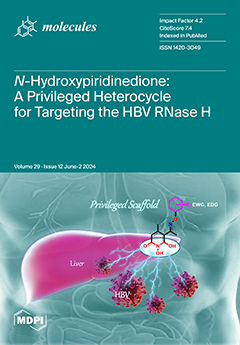Homogeneous catalysis involving a transition metal agostic interaction (TM
…H
…C) is an attractive strategy for C–H bond activation, in which the transition metal agostic intermediates serve as the critical component. To investigate the roles of manganese agostic intermediates in the
[...] Read more.
Homogeneous catalysis involving a transition metal agostic interaction (TM
…H
…C) is an attractive strategy for C–H bond activation, in which the transition metal agostic intermediates serve as the critical component. To investigate the roles of manganese agostic intermediates in the unusual migration of the Mn(CO)
3 fragment in the (exo-phenyl)(η
3-cyclohexenyl)manganese tricarbonyl [(Ph)(η
3-C
6H
8)Mn(CO)
3] (complex
1) under the protonation of tetrafluoroboric acid–diethyl ether (HBF
4.Et
2O), a comprehensive density functional theory (DFT) theoretical study was performed. The computational results showed that formation of the [(cyclohex-3-enyl)-η
6-benzene]manganese tricarbonyl complex [(C
6H
9)(η
6-Ph)Mn(CO)
3+][BF
4] (complex
2) was achieved via a series of mono-agostic and di-agostic intermediates. The overall rate-limiting step for this unusual migration of the Mn(CO)
3 fragment is the formation of the di-agostic (η
2-phenyl)manganese complex
8 (
4 →
5 →
8) with a Gibbs barrier of 15.4 kcal mol
−1. The agostic intermediates with TM
…H
…C agostic interactions were well-characterized by geometry parameters, Atoms-In-Molecules (AIM) analyses, and the Natural Adaptive Orbitals (NAdOs). The located pathways in the current study successfully explained the experimental observations, and the findings on the TM
…H
…C agostic interaction provided a new aspect of the catalytic reaction with the manganese complex.
Full article






